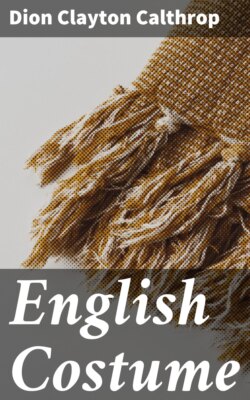Читать книгу English Costume - Dion Clayton Calthrop - Страница 15
THE WOMEN
ОглавлениеThe greatest change in the appearance of the women was in the arrangement of the hair.
After a hundred years or more of headcloths and hidden hair suddenly appears a head of hair. Until now a lady might have been bald for all the notice she took of her hair; now she must needs borrow hair to add to her own, so that her plaits shall be thick and long.
It is easy to see how this came about. The hair, for convenience, had always been plaited in two plaits and coiled round the head, where it lay concealed by the wimple. One day some fine lady decides to discard her close and uncomfortable head-covering. She lets her plaits hang over her shoulders, and so appears in public. Contempt of other ladies who have fine heads of hair for the thinness of her plaits; competition in thick and long hair; anger of ladies whose hair is not thick and long; enormous demand for artificial hair; failure of the supply to meet the ever-increasing demand; invention of silken cases filled with a substitute for hair, these cases attached to the end of the plaits to elongate them—in this manner do many fashions arrive and flourish, until such time as the common people find means of copying them, and then my lady wonders how she could ever have worn such a common affair.
The gowns of these ladies remained much the same, except that the loose gown, without any show of the figure, was in great favour; this gown was confined by a long girdle.
The girdle was a long rope of silk or wool, which was placed simply round the waist and loosely knotted; or it was wound round above the waist once, crossed behind, and then knotted in front, and the ends allowed to hang down. The ends of the girdle had tassels and knots depending from them.
The silk cases into which the hair was placed were often made of silk of variegated colours, and these cases had metal ends or tassels.
The girdles sometimes were broad bands of silk diapered with gold thread, of which manufacture specimens remain to us.
A WOMAN OF THE TIME OF HENRY I. (1100-1135)
This shows the pendant sleeve with an embroidered hem. The long plaits of hair ended with metal, or silk, tags. At the neck and wrists the white chemise shows.
The sleeves of the gowns had now altered in shape, and had acquired a sort of pendulent cuff, which hung down about two hands’ breadth from the wrist. The border was, as usual, richly ornamented.
Then we have a new invention, the pelisse. It is a loose silk coat, which is brooched at the waist, or buttoned into a silk loop. The sleeves are long—that is, they gradually increase in size from the underarm to the wrist, and sometimes are knotted at the ends, and so are unlike the other gown sleeves, which grow suddenly long near to the wrist.
This pelisse reaches to the knees, and is well open in front. The idea was evidently brought back from the East after the knights arrived back from the First Crusade, as it is in shape exactly like the coats worn by Persian ladies.
We may conceive a nice picture of Countess Constance, the wife of Hugh Lufus, Earl of Chester, as she appeared in her dairy fresh from milking the cows, which were her pride. No doubt she did help to milk them; and in her long under-gown, with her plaits once more confined in the folds of her wimple, she made cheeses—such good cheeses that Anselm, Archbishop of Canterbury, rejoiced in a present of some of them.
What a change it must have been to Matilda, free of the veil that she hated, from the Black Nuns of Romsey, and the taunts and blows of her aunt Christina, to become the wife of King Henry, and to disport herself in fine garments and long plaited hair—Matilda the very royal, the daughter of a King, the sister to three Kings, the wife of a King, the mother of an Empress!
